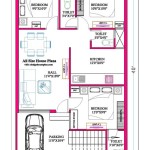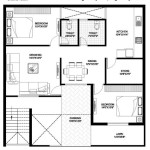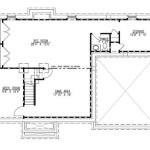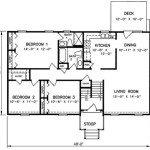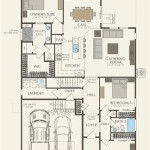Floor Plans For Four Bedroom Homes: A Comprehensive Guide
The demand for four-bedroom homes stems from a variety of needs, ranging from accommodating growing families to providing space for home offices, guest rooms, or hobby areas. Consequently, understanding the nuances of four-bedroom floor plans is essential for both potential homeowners and those looking to optimize their current living spaces. These plans vary significantly in layout, square footage, and overall design, catering to diverse lifestyles and preferences. This article explores the key considerations involved in selecting and analyzing floor plans for four-bedroom homes, focusing on functionality, aesthetics, and adaptability.
A four-bedroom floor plan essentially provides four distinct sleeping areas within a residential dwelling. However, the specific configuration of these bedrooms, along with the placement of other essential living spaces like the kitchen, living room, and bathrooms, drastically impacts the overall usability and appeal of the home. A well-designed floor plan maximizes space utilization, promotes smooth traffic flow, and creates distinct zones for relaxation, work, and entertainment. Conversely, a poorly conceived plan can lead to cramped quarters, awkward layouts, and a diminished quality of life for the occupants.
Understanding Key Design Considerations
Several fundamental design principles underpin the creation of effective four-bedroom floor plans. These considerations extend beyond the mere number of bedrooms and delve into the relationships between different areas within the home. Understanding these factors is critical in evaluating the suitability of a particular floor plan for individual needs.
One of the primary considerations is the separation of living spaces. Public areas, such as the living room, dining room, and kitchen, should ideally be grouped together to foster a sense of connectivity and facilitate social interaction. Simultaneously, these areas should be distinct from the private spaces, such as the bedrooms and bathrooms, to ensure tranquility and privacy. This segregation can be achieved through careful zoning, utilizing hallways, or employing architectural features like staircases or strategically placed walls.
Another critical element is the flow of circulation within the home. The floor plan should facilitate easy and intuitive movement between different areas, minimizing bottlenecks and unnecessary detours. Hallways should be adequately sized to accommodate traffic, and doorways should be positioned to avoid obstructing furniture placement. The overall layout should encourage a natural and unforced progression from one space to another.
Natural light and ventilation are also crucial aspects of a well-designed floor plan. The orientation of the home on the lot, the placement of windows, and the use of skylights can significantly impact the amount of natural light that enters the living spaces. Adequate ventilation is essential for maintaining air quality and preventing moisture buildup. Floor plans should ideally incorporate features that promote cross-ventilation, such as windows on opposite walls or strategically placed vents.
Finally, storage space is often an overlooked but essential consideration. Four-bedroom homes tend to house more occupants, requiring ample storage for clothing, linens, household goods, and other personal belongings. Floor plans should incorporate sufficient closet space in each bedroom, as well as additional storage areas throughout the home, such as linen closets, pantries, and garage storage.
Exploring Different Four-Bedroom Floor Plan Styles
The architectural style of a four-bedroom home significantly influences the layout and overall feel of the floor plan. Different styles prioritize different features and cater to distinct aesthetic preferences. Understanding the characteristics of various styles is crucial for selecting a floor plan that aligns with individual tastes and lifestyle requirements.
Ranch-style homes, typically characterized by a single-story layout, often feature a linear or L-shaped four-bedroom floor plan. The bedrooms are often located along one side of the house, while the living spaces are situated on the other. This style promotes ease of access and can be particularly suitable for individuals with mobility limitations. However, ranch-style homes may require a larger footprint, potentially increasing construction costs and lot size requirements.
Two-story homes offer a more compact footprint compared to ranch-style homes, making them suitable for smaller lots. Four-bedroom floor plans in two-story homes typically feature the bedrooms on the upper level, while the living spaces are located on the ground floor. This separation provides a clear distinction between public and private areas, enhancing privacy and reducing noise transmission. However, two-story homes may require navigating stairs, which can be a consideration for individuals with mobility challenges.
Split-level homes offer a unique variation on the two-story design, with different levels staggered vertically. Four-bedroom floor plans in split-level homes may feature the bedrooms on one level, the living spaces on another, and a garage or recreational area on a third. This design can create distinct zones within the home and provide a sense of privacy. However, split-level homes may require navigating multiple sets of stairs, which can be a drawback for some individuals.
Modern floor plans often emphasize open-concept living, with interconnected living spaces that promote social interaction and create a sense of spaciousness. Four-bedroom floor plans in modern homes may feature a large, open kitchen that flows seamlessly into the living and dining areas. The bedrooms may be grouped together in a separate wing of the house, providing privacy and noise isolation. Modern floor plans often incorporate large windows and clean lines, maximizing natural light and creating a contemporary aesthetic.
Analyzing Specific Floor Plan Features
Beyond the overall style, specific features within a four-bedroom floor plan can significantly impact its functionality and suitability for individual needs. Careful attention to these details is essential in evaluating the merits of a particular plan.
The master suite is a key feature of most four-bedroom homes. Ideally, the master suite should be spacious and include a private bathroom and walk-in closet. The master bathroom should be well-appointed with features such as a double vanity, a separate shower and tub, and ample storage. The walk-in closet should be adequately sized to accommodate clothing and accessories for two individuals. The location of the master suite within the floor plan is also important. Ideally, it should be situated away from the other bedrooms to ensure privacy and minimize noise disruption.
The size and configuration of the secondary bedrooms are also important considerations. The bedrooms should be adequately sized to accommodate a bed, a desk, and a dresser. The closets should be sufficiently large to store clothing and personal belongings. The placement of the bedrooms should also be considered. Ideally, they should be located near a bathroom and should be adequately insulated to minimize noise transmission.
The kitchen is the heart of the home, and its design is crucial for functionality and convenience. The kitchen should be spacious and well-equipped with appliances, including a refrigerator, a stove, a dishwasher, and a microwave. The layout should be efficient, with a clear workflow that allows for easy meal preparation and cleanup. The kitchen should also include ample counter space and storage. The location of the kitchen within the floor plan is also important. Ideally, it should be located near the dining area and should have easy access to the backyard or patio.
The living room is another important space in the home, serving as a gathering place for family and friends. The living room should be spacious and comfortable, with ample seating and a focal point, such as a fireplace or a large window. The layout should be conducive to conversation and relaxation. The location of the living room within the floor plan is also important. Ideally, it should be located near the entryway and should have easy access to the kitchen and dining area.
The bathrooms are essential for hygiene and comfort, and their design should be functional and aesthetically pleasing. The bathrooms should be well-ventilated and should include a toilet, a sink, and a shower or tub. The layout should be efficient and easy to clean. The bathrooms should also include ample storage for toiletries and towels. The location of the bathrooms within the floor plan is also important. Ideally, they should be located near the bedrooms and should be easily accessible to guests.
Finally, the presence of additional spaces, such as a home office, a playroom, or a mudroom, can significantly enhance the functionality and appeal of a four-bedroom home. A home office provides a dedicated space for work or study, while a playroom offers a safe and stimulating environment for children. A mudroom provides a transition space between the outdoors and the indoors, helping to keep the home clean and organized. The inclusion of these additional spaces should be carefully considered based on individual needs and lifestyle preferences.

4 Bedroom House Plan Examples

Beautiful Affordable 4 Bedroom House Plans New Home Design

Four Bedroom House Plans Perfect For Your Family Houseplans Blog Com

Lovely 2 Story 4 Bedroom House Floor Plans New Home Design

Lauien 4 Bedroom Rustic Lake Style House Plan 7545

House Plan 2559 00940 Modern Farmhouse 3 669 Square Feet 4 Bedrooms 5 Bathrooms

Plan 82055ka Four Bedroom One Story House

Minimalist Single Story House Plan With Four Bedrooms And Two Bathrooms Cool Concepts

Plan 55150br Budget Friendly 4 Bed House

Two Story 4 Bedroom Home Plan With 3 Car Garage

